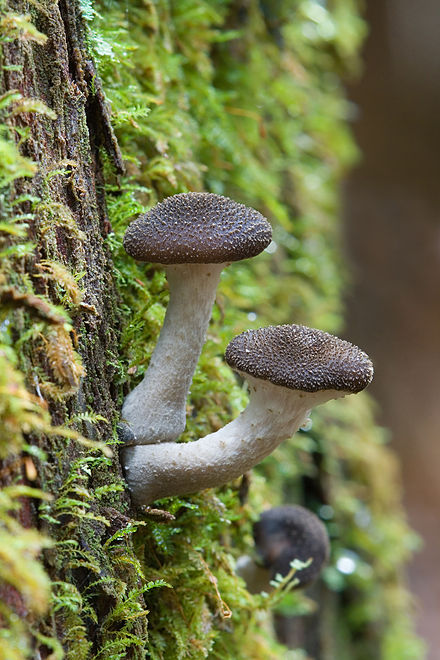Armillaria
Armillaria is a genus of fungi that includes the A. mellea species known as honey fungi that live on trees and woody shrubs. It includes about 10 species formerly categorized summarily as A. mellea. Armillarias are long-lived and form the largest living fungi in the world. The largest known organism (of the species Armillaria ostoyae) covers more than 3.4 square miles (8.8 km2) in Oregon's Malheur National Forest and is estimated to be 2,500 years old.[1][2] Some species of Armillaria display bioluminescence, resulting in foxfire.
Armillaria can be a destructive forest pathogen. It causes "white rot" root disease (see Plant pathology section) of forests, which distinguishes it from Tricholoma, a mycorrhizal (non-parasitic) genus. Because Armillaria is a facultative saprophyte, it also feeds on dead plant material, allowing it to kill its host, unlike parasites that must moderate their growth to avoid host death.[2]
The basidiocarp (reproductive structure) of the fungus is a mushroom that grows on wood, typically in small dense clumps or tufts. Their caps (mushroom tops) are typically yellow-brown, somewhat sticky to touch when moist, and, depending on age, may range in shape from conical to convex to depressed in the center. The stipe (stalk) may or may not have a ring. All Armillaria species have a white spore print and none have a volva (cup at base) (compare Amanita).[3]
Similar species include Pholiota spp. which also grow in cespitose (mat-like) clusters on wood and fruit in the fall. Pholiota spp. are separated from Armillaria by its yellowish to greenish-yellow tone and a dark brown to grey-brown spore print. Mushroom hunters need to be wary of Galerina spp. which can grow side by side with Armillaria spp. on wood. Galerina have a dark brown spore print and are deadly poisonous (alpha-amanitin) – see: mushroom poisoning.
Honey fungus is a "white rot" fungus, which is a pathogenic organism that affects trees, shrubs, woody climbers and rarely, woody herbaceous perennial plants. Honey fungus can grow on living, decaying, and dead plant material.
Honey fungus spreads from living trees, dead and live roots and stumps by means of reddish-brown to black rhizomorphs (root-like structures) at the rate of approximately 3.3 feet (1 m) a year, but infection by root contact is possible. Infection by spores is rare. Rhizomorphs grow close to the soil surface (in the top 7.9 inches (20 cm)) and invade new roots, or the root collar (where the roots meet the stem) of plants. An infected tree will die once the fungus has girdled it, or when significant root damage has occurred. This can happen rapidly, or may take several years. Infected plants will deteriorate, although may exhibit prolific flower or fruit production shortly before death.

